- Region
- Águilas
- Alhama de Murcia
- Jumilla
- Lorca
- Los Alcázares
- Mazarrón
- San Javier
-
ALL AREAS & TOWNS
- AREAS
- SOUTH WEST
- MAR MENOR
- MURCIA CITY & CENTRAL
- NORTH & NORTH WEST
- TOWNS
- Abanilla
- Abarán
- Aguilas
- Alamillo
- Alcantarilla
- Aledo
- Alhama de Murcia
- Archena
- Balsicas
- Blanca
- Bolnuevo
- Bullas
- Cañadas del Romero
- Cabo de Palos
- Calasparra
- Camping Bolnuevo
- Campo De Ricote
- Camposol
- Canada De La Lena
- Caravaca de la Cruz
- Cartagena
- Cehegin
- Ceuti
- Cieza
- Condado de Alhama
- Corvera
- Costa Cálida
- Cuevas De Almanzora
- Cuevas de Reyllo
- El Carmoli
- El Mojon
- El Molino (Puerto Lumbreras)
- El Pareton / Cantareros
- El Raso
- El Valle Golf Resort
- Fortuna
- Fuente Alamo
- Hacienda del Alamo Golf Resort
- Hacienda Riquelme Golf Resort
- Isla Plana
- Islas Menores & Mar de Cristal
- Jumilla
- La Azohia
- La Charca
- La Manga Club
- La Manga del Mar Menor
- La Pinilla
- La Puebla
- La Torre
- La Torre Golf Resort
- La Unión
- Las Palas
- Las Ramblas
- Las Ramblas Golf
- Las Torres de Cotillas
- Leiva
- Librilla
- Lo Pagan
- Lo Santiago
- Lorca
- Lorquí
- Los Alcázares
- Los Balcones
- Los Belones
- Los Canovas
- Los Nietos
- Los Perez (Tallante)
- Los Urrutias
- Los Ventorrillos
- Mar De Cristal
- Mar Menor
- Mar Menor Golf Resort
- Mazarrón
- Mazarrón Country Club
- Molina de Segura
- Moratalla
- Mula
- Murcia City
- Murcia Property
- Pareton
- Peraleja Golf Resort
- Perin
- Pilar de la Horadada
- Pinar de Campoverde
- Pinoso
- Playa Honda
- Playa Honda / Playa Paraíso
- Pliego
- Portmán
- Pozo Estrecho
- Puerto de Mazarrón
- Puerto Lumbreras
- Puntas De Calnegre
- Region of Murcia
- Ricote
- Roda Golf Resort
- Roldan
- Roldan and Lo Ferro
- San Javier
- San Pedro del Pinatar
- Santiago de la Ribera
- Sierra Espuña
- Sucina
- Tallante
- Terrazas de la Torre Golf Resort
- Torre Pacheco
- Totana
- What's On Weekly Bulletin
- Yecla


- EDITIONS:
 Spanish News Today
Spanish News Today
 Alicante Today
Alicante Today
 Andalucia Today
Andalucia Today
Parroquía de San José in Águilas
The main church of Águilas is a 19th century building in the Plaza de España
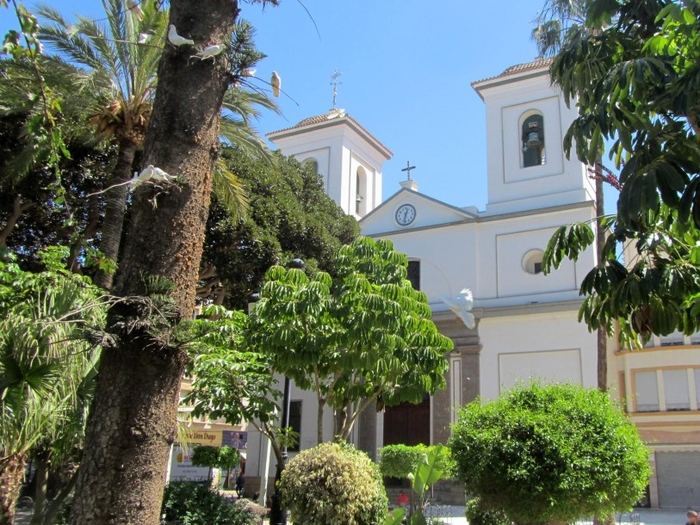
The first church in Águilas was an old esparto grass warehouse which was converted into a place of worship in 1790 and dedicated to Our Lady of the Purísima Concepción and San Indalecio. This was the moment when the church of Águilas became independent from the ecclesiastical authorities in Lorca, but at the beginning of the following century it was decided that a more fitting building for Christian worship was required.
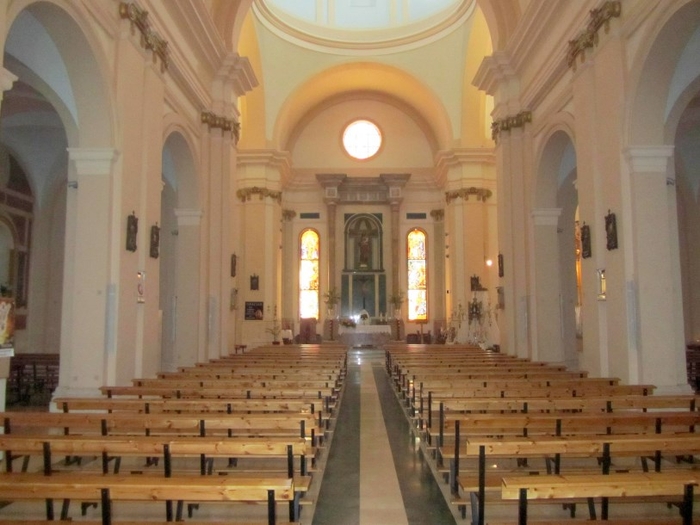 An initial project had already been put forward by the Conde de Floridablanca in 1787, with a sumptuous design based on the church of Santa Bárbara in Madrid, but this proposal foundered when the Count fell from favour five years later.
An initial project had already been put forward by the Conde de Floridablanca in 1787, with a sumptuous design based on the church of Santa Bárbara in Madrid, but this proposal foundered when the Count fell from favour five years later.
By 1810, though, the population of Águilas had doubled despite the Napoleonic Wars, and the old warehouse was no longer acceptable or large enough for the increased congregation, some of whom were forced to attend Mass in the streets outside. As a result a block of old houses and shacks was demolished in the Plaza de España and the Bishop of Cartagena gave his authorization for a church to be built. The design was entrusted to Juan Cayetano Morata, and funding was supplied both by King Fernando VII and by the generous donations of the residents of the town.
Construction lasted a total of 43 years, ending in 1853 when the building was consecrated, and since then it has stood at the north-eastern corner of the Plaza de España, opposite the Town Hall.
From the outside the façade is a reflection of the period in which the church was built; here there is none of the baroque ornamentalism which characterizes some of the Region of Murcia’s most admired churches and the cathedral in the city of Murcia, but instead a simple and sober appearance looks out onto the Plaza de España. It’s a pleasing design, even though it is partially obscured by the large ficus tree which grows in front of it.
At the top are two simple bell-towers, and the main door to the church is flanked by double pillars which lead up to a window housed in a semi-circular arch. The clock is housed in a triangular top piece, on which is mounted a simple cross.
Inside, the main nave consists of three aisles with a choir at the foot of the nave and a dome over the chancel. The side chapels and the transept do not extend the building laterally, so the church is rectangular rather than cross-shaped.
The interior is also understated in its decoration compared to many other places of worship in Spain, with grey and white the dominant colours. The Capillo del Santísimo which houses the image of the Sagrado de Corazón de Jesús is at the head of the church on the left, while on the right is the sacristy.
The marble altar screen is a recent addition, dating from renovation work carried out in 2003, and the stained glass windows come from the same reforms. The white, red and grey marble which adorns the side chapels is from Macael in the neighbouring province of Almería.
Works of religious art
Most of the works of religious art inside the Iglesia de San José in Águilas date from the 20th century, although there are a couple which are older and which were donated to the church from elsewhere.
The most prominent and probably the most impressive is the figure of the Virgen de los Dolores (Our Lady of Sorrows), who is one of the patrons of Águilas (together with San José). This statue is housed in a niche on the right-hand side of the church surrounded by four golden columns on top of which sit angels and above which is a representation of the Sagrado Corazón, and was the only one in this church to escape the destruction and ransacking of churches during the Civil War (1936-39). 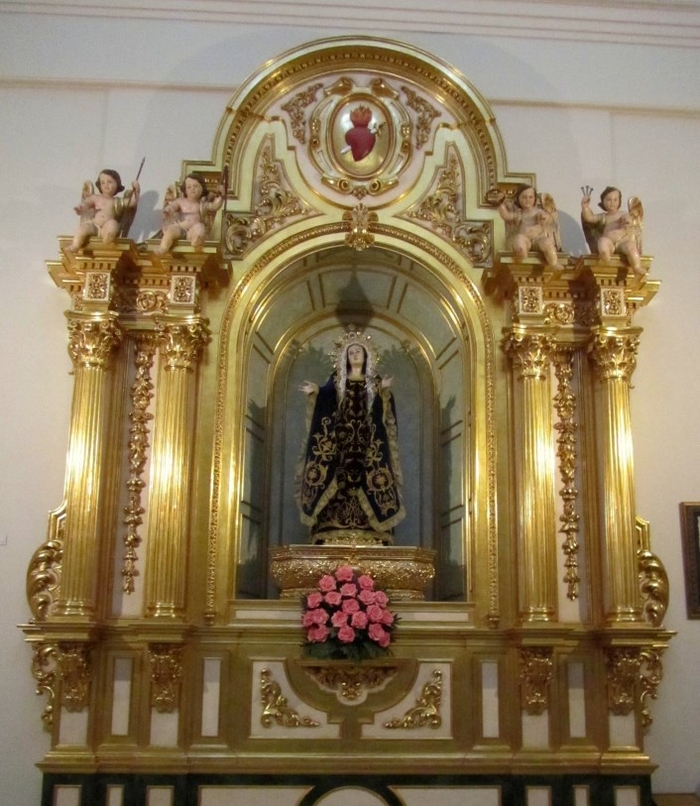
This figure shows the Virgin Mary with her arms open and looking skywards as she anticipates the death of her son, and is one of the older ones currently in the church. It was already venerated by the residents of Águilas in the small church in Calle Lara, and then in another in Calle Floridablanca, before the Iglesia de San José was completed.
The town council officially adopted the Virgen de los Dolores in 1855, and this decision was ratified in 19636 by Pope John XXIII.
Although the figure is carved in the style of the great Francisco Salzillo the opinion of the 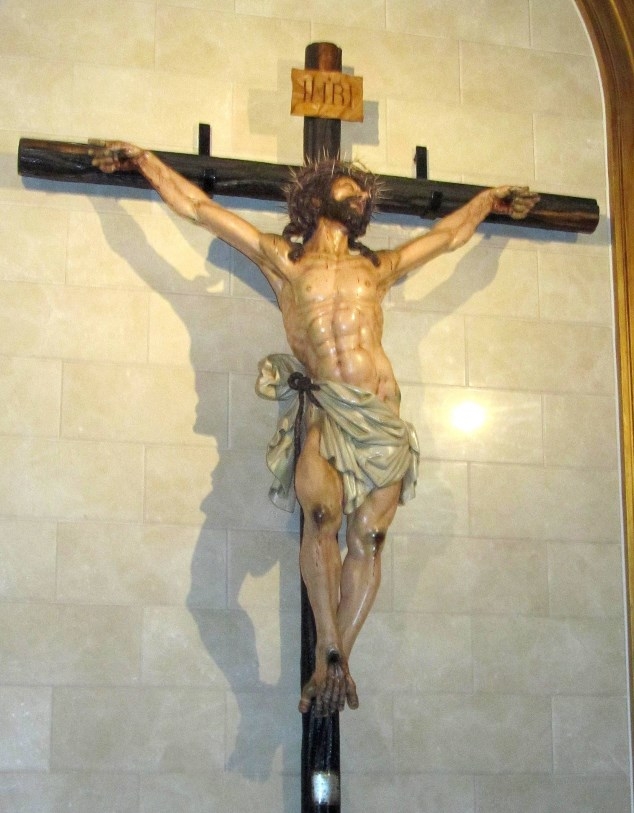 experts is that it cannot be the work of the master himself because when it first came to the small warehouse-church in 1808 Salzillo had been dead for 25 years. Roque López has also been discounted as the creator of this figure, because it doesn’t figure on the catalogue of works produced by the Conde de Roche, and the informed speculationis that the sculptor was probably Francisco Fernández Caro, a native of Caravaca de la Cruz who set up business in Águilas from 1800 to 1804.
experts is that it cannot be the work of the master himself because when it first came to the small warehouse-church in 1808 Salzillo had been dead for 25 years. Roque López has also been discounted as the creator of this figure, because it doesn’t figure on the catalogue of works produced by the Conde de Roche, and the informed speculationis that the sculptor was probably Francisco Fernández Caro, a native of Caravaca de la Cruz who set up business in Águilas from 1800 to 1804.
Another prominent work inside the Iglesia de San José is the Cristo de la Agonía, which was sculpted in the mid-20th century by José Rivera. The anatomical precision of this figure is especially noteworthy, reflecting the pain of Christ on the Cross, and his body shows various cuts and bruises.
The figure of Nuestro Padre Jesús Nazareno, which is also from the 20th century, shows Christ carrying the 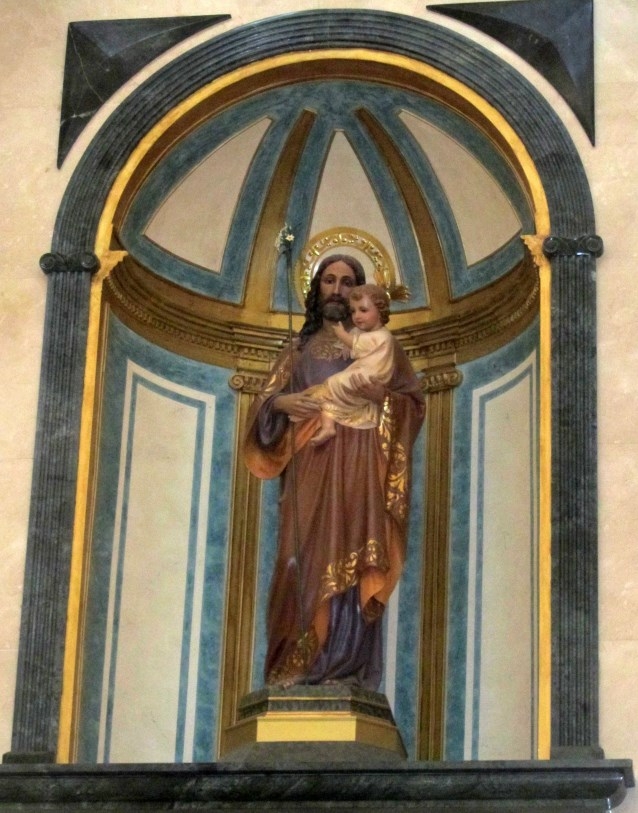 Cross, and under the Crown of thorns is a wig, rather than a sculpted representations of the Saviour’s hair.
Cross, and under the Crown of thorns is a wig, rather than a sculpted representations of the Saviour’s hair.
On the left-hand side of the church is the small figure of the Virgen del Rocío, which is featured in a Romería every May.
The figure of the La Virgen del Carmen, another 20th century work, shows the Blessed Virgin with the infant Jesus in her left arm and a small scapular in her right hand, and behind the altar is the figure of San José, also holding the young Jesus
Among the paintings adorning the walls of the church is one by local artist and photographer José Matrán Tudela dated 1946, showing the Patriarch as a young man in the clouds with Jesus in the crook of his left arm while angels hold his flowery staff, and two others are by Manuel Muñóz Barberán, one of them depicting the Last Supper in great detail at the moment of the blessing of the bread.
More information about Águilas including beaches, what to see, what's on and tourist information can be found on ÁGUILAS TODAY
Cartagena
El Carmoli
Islas Menores and Mar de Cristal
La Manga Club
La Manga del Mar Menor
La Puebla
La Torre Golf Resort
La Union
Los Alcazares
Los Belones
Los Nietos
Los Urrutias
Mar Menor Golf Resort
Pilar de la Horadada
Playa Honda / Playa Paraiso
Portman
Roldan and Lo Ferro
San Javier
San Pedro del Pinatar
Santa Rosalia Lake and Life resort
Terrazas de la Torre Golf Resort
Torre Pacheco
Aledo
Alhama de Murcia
Bolnuevo
Camposol
Condado de Alhama
Fuente Alamo
Hacienda del Alamo Golf Resort
Lorca
Mazarron
Puerto de Mazarron
Puerto Lumbreras
Sierra Espuna
Totana
Abaran
Alcantarilla
Archena
Blanca
Corvera
El Valle Golf Resort
Hacienda Riquelme Golf Resort
Lorqui
Molina de Segura
Mosa Trajectum
Murcia City
Peraleja Golf Resort
Ricote
Sucina
Condado de Alhama
El Valle Golf Resort
Hacienda del Alamo Golf Resort
Hacienda Riquelme Golf Resort
Islas Menores and Mar de Cristal
La Manga Club
La Torre Golf Resort
Mar Menor Golf Resort
Mazarron Country Club
Mosa Trajectum
Peraleja Golf Resort
Santa Rosalia Lake and Life resort
Terrazas de la Torre Golf Resort
La Zenia
Lomas de Cabo Roig
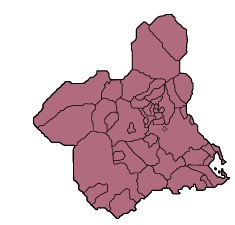
CAMPOSOL TODAY Whats OnCartagena SpainCoronavirusCorvera Airport MurciaMurcia Gota Fria 2019Murcia property news generic threadWeekly Bulletin
